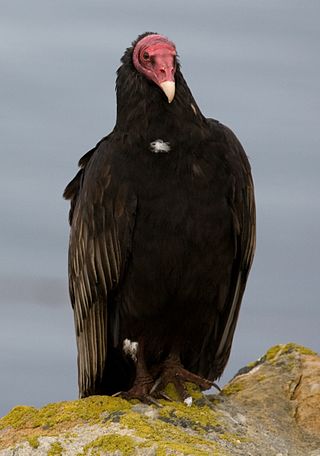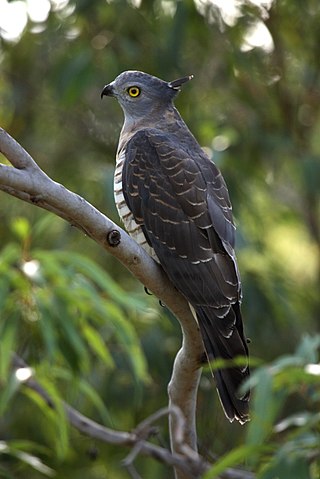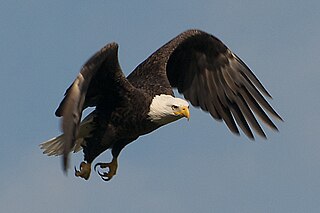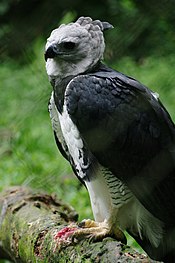
Eagle is the common name for the golden eagle, bald eagle, and other birds of prey in the family Accipitridae. Eagles belong to several groups of genera, some of which are closely related. True eagles comprise the genus Aquila. Most of the 68 species of eagles are from Eurasia and Africa. Outside this area, just 14 species can be found—two in North America, nine in Central and South America, and three in Australia.

Birds of prey or predatory birds, also known as raptors, are hypercarnivorous bird species that actively hunt and feed on other vertebrates. In addition to speed and strength, these predators have keen eyesight for detecting prey from a distance or during flight, strong feet with sharp talons for grasping or killing prey, and powerful, curved beaks for tearing off flesh. Although predatory birds primarily hunt live prey, many species also scavenge and eat carrion.

A harrier is any of the several species of diurnal hawks sometimes placed in the subfamily Circinae of the bird of prey family Accipitridae. Harriers characteristically hunt by flying low over open ground, feeding on small mammals, reptiles, or birds. The young of the species are sometimes referred to as ring-tail harriers. They are distinctive with long wings, a long narrow tail, the slow and low flight over grasslands and skull peculiarities. The harriers are thought to have diversified with the expansion of grasslands and the emergence of C4 grasses about 6 to 8 million years ago during the Late Miocene and Pliocene.

The Accipitridae is one of the three families within the order Accipitriformes, and is a family of small to large birds of prey with strongly hooked bills and variable morphology based on diet. They feed on a range of prey items from insects to medium-sized mammals, with a number feeding on carrion and a few feeding on fruit. The Accipitridae have a cosmopolitan distribution, being found on all the world's continents and a number of oceanic island groups. Some species are migratory. The family contains 255 species which are divided into 70 genera.

Cathartidae, known commonly as New World vultures or condors, are a family of birds of prey consisting of seven extant species in five genera. It includes five extant vultures and two extant condors found in warm and temperate areas of the Americas. They are known as "New World" vultures to distinguish them from Old World vultures, with which the Cathartidae does not form a single clade despite the two being similar in appearance and behavior as a result of convergent evolution.

Aegypiinae is one of two subfamilies of Accipitridae that are referred to as Old World vultures, the other being the Gypaetinae. They are not closely related to the Gypaetinae, and are instead a sister group to the serpent-eagles (Circaetinae).

The Buteoninae are a subfamily of birds of prey which consists of medium to large, broad-winged species.

Circaetinae is a bird of prey subfamily which consists of a group of medium to large broad-winged species. The group is sometimes treated as tribe Circaetini. These birds mainly specialise in feeding on snakes and other reptiles, which is the reason most are referred to as "snake-eagles" or "serpent-eagles". The exceptions are the bateleur, a more generalised hunter, and the Philippine eagle, which preys on mammals and birds.

The raptor subfamily Perninae includes a number of medium-sized broad-winged species. These are birds of warmer climates, although the Pernis species have a more extensive range.

An elanine kite is any of several small, lightly-built raptors with long, pointed wings.

A sea eagle or fish eagle is any of the birds of prey in the subfamily Haliaeetinae of the bird of prey family Accipitridae. Ten extant species exist, currently described with this label.

Icthyophaga or Ichthyophaga is a genus of six species of eagles, closely related to the sea eagles in the genus Haliaeetus. In fact, some taxonomic authorities place this genus within Haliaeetus. Both are native to southeastern Asia, from the Indian subcontinent southeast to Sulawesi. They are smaller than the Haliaeetus eagles, though overlapping in size with the smaller species of that genus. They share similar plumage, with grey heads grading into dull grey-brown wings and bodies, and white belly and legs. They differ in tail colour, with the lesser fish eagle having a brown tail, and the grey-headed fish eagle having a white tail with a black terminal band, and also in size, with the lesser fish eagle only about half of the weight of the grey-headed fish eagle.

The genus Hieraaetus, sometimes known as small eagles or hawk-eagles, denotes a group of smallish eagles usually placed in the accipitrid subfamilies Buteoninae or Aquilinae.
The black honey-buzzard, also commonly known as the New Britain Honey-Buzzard, is a large raptor of the family Accipitridae. Standing at around 50 cm (20 in) tall, the adult black honey-buzzard has a dark head and body, with striking white bands on its tail and flight feathers. When in flight, the buzzard can be recognized by its long wings and noticeably large secondary feathers. It is thought to be sedentary, with a range limited to the island of New Britain in Papua New Guinea, where it is endemic. Due to its remote habitat and tendency to remain in densely forested areas, there is currently much to learn about this striking species.

Nisaetus is a genus of subfamily Aquilinae found mainly in tropical Asia. They were earlier placed within the genus Spizaetus but molecular studies show that the Old World representatives were closer to the genus Ictinaetus than to the New World Spizaetus. They are slender-bodied, medium-sized hawk-eagles with rounded wings, long feathered legs, barred wings, crests and usually adapted to forest habitats.

The Gypaetinae is one of two subfamilies of Old World vultures the other being the Aegypiinae. Some taxonomic authorities place the Gypaetinae within the Perninae hawks. They are presently found throughout much of Africa, Asia, and southern Europe, hence being considered "Old World" vultures, but as recently as the Late Pleistocene, they were also present in North America.

The Aquilinae are a subfamily of eagles of the family Accipitridae. The general common name used for members of this subfamily is "booted eagle", although this is also the common name of a member of the subfamily. At one point, this subfamily was considered inclusive with the Buteoninae based probably on some shared morphological characteristics. However, research on the DNA of the booted eagles has shown that they are a monophyletic group that probably have had millions of years of separation from other extant forms of accipitrid.
Booted eagles are eagles that have fully feathered tarsi. That is, their legs are covered with feathers down to the feet. Most other accipitrids have bare lower legs, scaled rather than feathered.
Cryptogyps is an extinct genus of Old World vulture from the Pleistocene of Australia. It was relatively small for a vulture but still larger than the extant wedge-tailed eagle. Originally described as an eagle in 1905, in 2022 it was reidentified as a vulture, the first known example from the continent. Phylogenetic analysis suggests it either being a sister species to the extant, widespread Eurasian vulture genus Gyps or as a more basal member of the subfamily. The identification of Cryptogyps as a vulture solves a longstanding mystery about the lack of specialized lineages of large scavenging birds in Australia despite being present on every other continent aside from Antarctica. It is likely that Cryptogyps went extinct towards the end of the Pleistocene due to the disappearance of the megafauna it depended on for carrion. The genus contains a single species, C. lacertosus.

Microspizias is a genus of bird of prey in the family Accipitridae. It contains the following species:





















